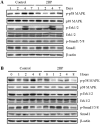Protein palmitoylation regulates osteoblast differentiation through BMP-induced osterix expression
- PMID: 19125191
- PMCID: PMC2607547
- DOI: 10.1371/journal.pone.0004135
Protein palmitoylation regulates osteoblast differentiation through BMP-induced osterix expression
Abstract
Osteoporosis is one of the most common diseases and can be treated by either anti-resorption drugs, anabolic drugs, or both. To search for anabolic drug targets for osteoporosis therapy, it is crucial to understand the biology of bone forming cells, osteoblasts, in terms of their proliferation, differentiation, and function. Here we found that protein palmitoylation participates in signaling pathways that control osterix expression and osteoblast differentiation. Mouse calvarial osteoblasts express most of the 24 palmitoyl transferases, with some being up-regulated during differentiation. Inhibition of protein palmitoylation, with a substrate-analog inhibitor, diminished osteoblast differentiation and mineralization, but not proliferation or survival. The decrease in differentiation capacity is associated with a reduction in osterix, but not Runx2 or Atf4. Inhibition of palmitoyl transferases had little effect in p53(-/-) osteoblasts that show accelerated differentiation due to overexpression of osterix, suggesting that osterix, at least partially, mediated the effect of inhibition of palmitoyl transferases on osteoblast differentiation. BMPs are the major driving force of osteoblast differentiation in the differentiation assays. We found that inhibition of palmitoyl transferases also compromised BMP2-induced osteoblast differentiation through down-regulating osterix induction. However, palmitoyl transferases inhibitor did not inhibit Smad1/5/8 activation. Instead, it compromised the activation of p38 MAPK, which are known positive regulators of osterix expression and differentiation. These results indicate that protein palmitoylation plays an important role in BMP-induced MAPK activation, osterix expression, and osteoblast differentiation.
Conflict of interest statement
Figures







References
-
- Manolagas SC, Jilka RL. Bone marrow, cytokines, and bone remodeling. Emerging insights into the pathophysiology of osteoporosis. N Engl J Med. 1995;332:305–311. - PubMed
-
- Martin TJ, Sims NA. Osteoclast-derived activity in the coupling of bone formation to resorption. Trends Mol Med. 2005;11:76–81. - PubMed
-
- Canalis E, Economides AN, Gazzerro E. Bone morphogenetic proteins, their antagonists, and the skeleton. Endocr Rev. 2003;24:218–235. - PubMed
-
- Zaidi M, Blair HC, Moonga BS, Abe E, Huang CL. Osteoclastogenesis, bone resorption, and osteoclast-based therapeutics. J Bone Miner Res. 2003;18:599–609. - PubMed
Publication types
MeSH terms
Substances
LinkOut - more resources
Full Text Sources
Research Materials
Miscellaneous

